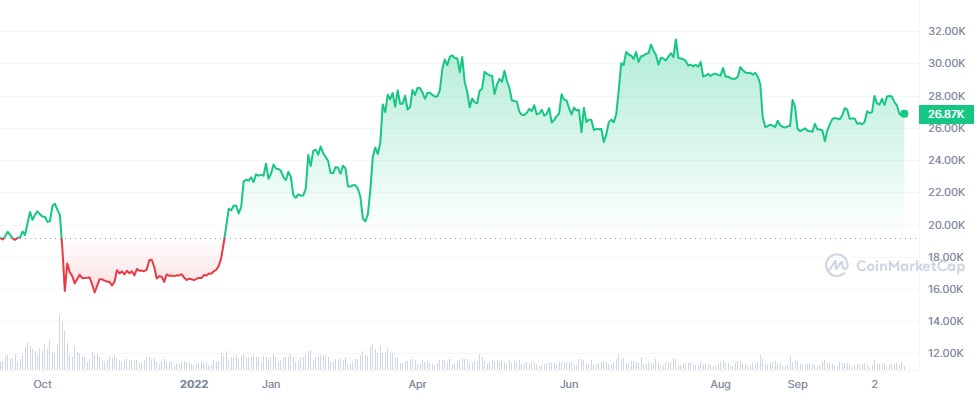The advancement of Layer 2 solutions, particularly those that aim to offer smart contract capabilities on Bitcoin, has ushered in a fervent debate about the technological direction and marketing narratives in the Bitcoin ecosystem. One such technology under the spotlight is BitVM, a development that has been touted by some as a “Virtual Machine” (VM) for Bitcoin.
Muneeb, Co-creator of Stacks and CEO of Trust Machines offers a more nuanced view of BitVM, describing it as an “interesting research experiment” but highlighting its key limitations. This article delves into Muneeb’s analysis to demystify the BitVM construct, how it contrasts with full VMs like Ethereum Virtual Machine (EVM) or Solana VM, and what this means for developers, users, and investors in the Bitcoin ecosystem.
BitVM: An Overview
BitVM, according to Muneeb, uses Bitcoin’s Layer 1 (L1) merely as a data plane, serving as a playground for two participating parties to interact. In these interactions, one party assumes the role of a “prover,” aiming to validate certain computations, while the other acts as a “verifier.” Notably, this mechanism does not involve Bitcoin L1 in the verification process, instead relegating it to a data storage role.
Key Limitations of BitVM
Muneeb outlines three critical limitations of BitVM when compared to full VMs:
- Verification Mechanism: Unlike full VMs like Ethereum‘s EVM or Solana VM, where computations are verified at their Layer 1, BitVM operates without Bitcoin L1’s verification. Verification is executed by a third-party user, external to the Bitcoin protocol.
- User Limitations: Full VMs accommodate an unlimited number of users, while BitVM restricts the interaction to just two parties. These parties must know each other in advance and perform extensive work offline.
- Operational Inefficiency: BitVM uses low-level NAND circuits to express its programs, contrasting with the high-level languages used in full VMs. This approach is highly inefficient and impractical, involving a lot of offline communication and data overhead, even for basic interactions.
R&D vs. Commercial Viability
Muneeb argues that while BitVM serves as an exciting research and development (R&D) experiment, exploring what might be possible using existing Bitcoin op-codes, it should not be billed as a full VM. He suggests the term “BitProver” as a more accurate description. The technology might evolve to address unanticipated, crucial use-cases, but as it stands, it does not compete with established VMs in terms of capabilities. Muneeb further emphasizes the risk of sending misleading marketing messages, which can distort the perception among non-technical users.
Implications & Future Outlook
- Developers: Understanding the limitations of BitVM is essential for developers who are considering building on top of Bitcoin. Overhyping its capabilities could lead to disillusionment and mistrust within the community.
- Users: For end-users, the distinction between BitVM and full VMs like EVM or Solana VM is crucial. Misunderstanding the capabilities of BitVM could result in misguided expectations about what Bitcoin can or cannot do in the realm of smart contracts.
- Investors: Investors need to exercise caution and conduct thorough due diligence before investing in projects that claim to bring full VM capabilities to Bitcoin. Overestimation of BitVM’s capabilities could lead to investment risks.
- Bitcoin Ecosystem: As the Bitcoin ecosystem evolves, it is essential to welcome experimentation and R&D efforts like BitVM. However, differentiating these from commercially viable solutions is critical for the ecosystem’s integrity and growth.
BTC Price Chart 2023

Who Will Win the DeFi Battle?
BitVM, while an intriguing experiment, falls considerably short of the capabilities offered by full VMs like Ethereum’s EVM or Solana‘s VM. While it might have the potential to evolve into a more robust solution, its current form is limited both in terms of user interaction and computational verification. As such, it is imperative for all stakeholders, developers, users, and investors alike, to have a nuanced understanding of what BitVM can and cannot offer.
It is equally crucial to align marketing narratives with the technology’s real-world applications to avoid misleading the broader community. As Muneeb aptly concludes, BitVM is an R&D effort worth following, but its current limitations should be clearly delineated from the capabilities of fully operational VMs.
Author Profile

- Ex-community moderator of the Banano memecoin. I have since been involved with numerous cryptocurrencies, NFT projects and DeFi organizations. I write about crypto mainly.
Latest entries
- June 6, 2025NewsWireElon Musk to Decommission SpaceX Dragon after Trump Threat
- December 9, 2024Stock MarketMaster the Time Value of Money Financial Concept
- November 18, 2024Stock MarketFinancial Ratios Guide to Measuring Business Performance
- November 11, 2024NewsWireLabour’s UK Budget: A Fiscal Smirk of Contempt for Working People




